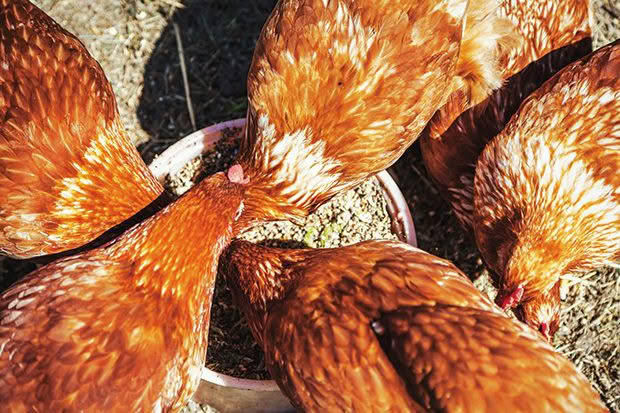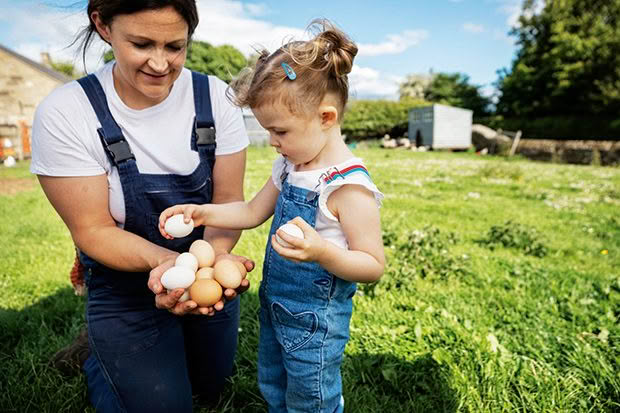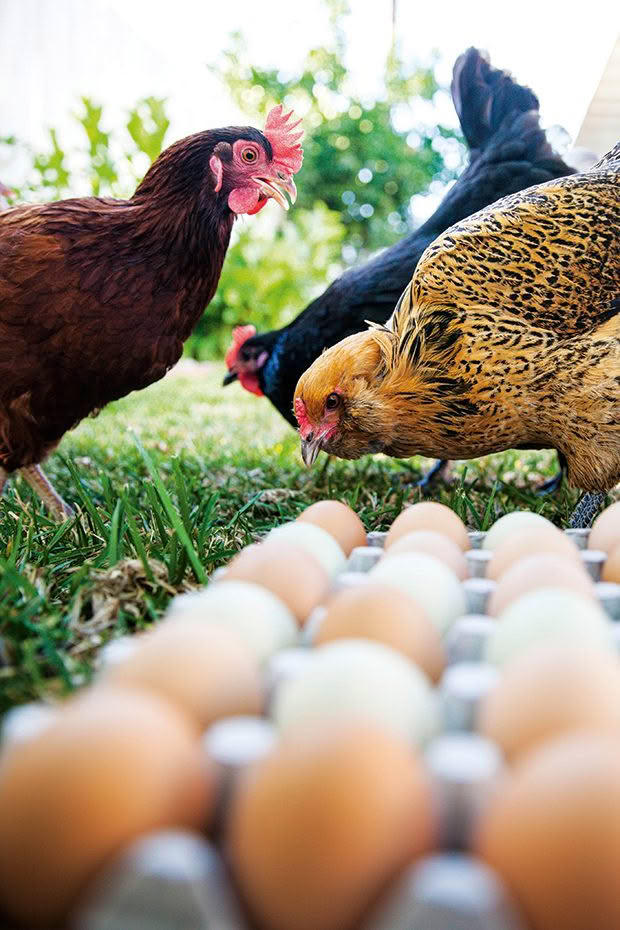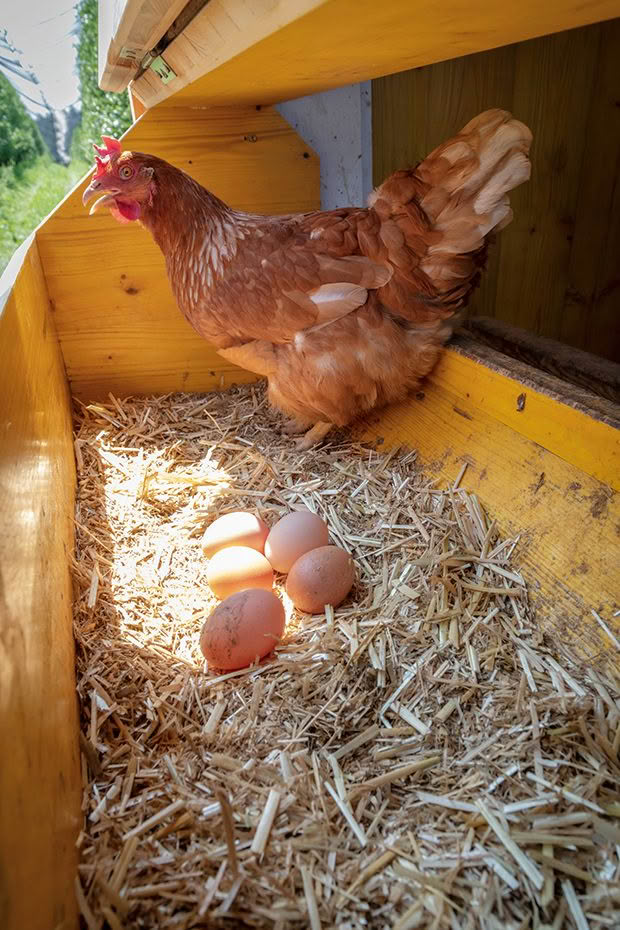Keeping the egg shortage from your block

The egg shortage has shown just how important homegrown eggs are. So how do you keep them coming?
Words: Andrea Graves
You’ll no doubt have seen the empty supermarket shelves that have resulted from New Zealand’s egg shortage. It hit right before Christmas when pavlova ingredients were key shopping list items. But if you were like me, you continued baking and feasting unconcerned because there were plenty of homegrown eggs landing in your nest boxes. After all, spring and early summer are peak laying times. If you want to keep the good times rolling, however, you’ll need to put in place strategies to maximise egg production and minimise the cost throughout the year. Here are the most important factors to be aware of.
FEED AND FEED GEAR
Feed is the biggest cost for egg producers, whether at home or on commercial farms. And while we might feel smug when we have our own laying hens, anyone who buys chook food is still dependent on global food supplies to feed them. The price of feed has gone up significantly in recent months thanks to international pressures, and there may be more price rises on the way. According to the Poultry Industry Association’s executive director, Michael Brooks, this is because fixed-price arrangements between feed manufacturers and grain producers are coming to an end.
It’s possible to make up your own feed mixtures, which may or may not be cheaper. But if possible, try sticking to a layer food that’s been formulated by an animal nutritionist to provide laying hens with what they need, and in the right balance, to lay as prolifically as possible. It might not seem as “natural” as a purely foraged diet, but the number of eggs that today’s hens lay is far beyond what’s “natural”, especially when it comes to the modern hybrid breeds. You can always supplement the layer feed with nutritionally dense titbits such as veggies, fruit, fish, meat scraps, worms, snails and cockroaches. There’s no need to ration feed; chooks don’t overeat and grow fat.
You can make sure none of your bought-in feed is wasted by buying a good hopper-style feeder that only opens when the chook activates it, usually by stepping on a platform. These can be expensive, but will save on feed in the long run because less goes to freeloading sparrows. As an aside, if you’re not providing free food to wild birds, then it may result in fewer parasite infestations, which can suck energy out of laying hens and reduce their egg output.

BREED
If eggs are your absolute priority, there are only two breeds of chook to choose from: Hy-Lines or brown shavers. These are used by commercial egg producers and are a hybrid of other, older breeds including the Leghorn. I recently read a 1971 essay by E B White, author of Charlotte’s Web and a chicken-keeper himself, who wrote of the White Leghorn hen: “She is nervous, she is flighty, she is the greatest egg machine on two legs, … She’s never too distracted to do her job. A Leghorn hen, if she were on her way to a fire, would pause long enough to lay an egg. This endears her to the poultrymen of America, who are out to produce the greatest number of eggs for the least money paid out for feed.”
Thanks to the genes of the Leghorn, the New Hampshire and Rhode Island Red, the modern hybrid was spawned in the 1950s, and the egg to feed ratio has continued to increase with each passing decade.
If you can choose, I’ve found Hy-Lines to have gentler natures than shavers, but I’m sure some people claim the opposite. Neither have the nervous flightiness of their great-great-grandmother, the White Leghorn.
My neighbour kept that breed, and I reckon you have to be a very energetic chicken keeper to keep pace with them. But they are hardy. One of my neighbour’s Leghorns got such an adrenaline shot from the flapping of her own outsized comb that she shot over the fence and fled into the local urban bush patch. When I caught her six weeks later she was the picture of health but still tormented by her floppy comb.

BUYING
If you want more eggs, you might need more hens. These are currently in demand; at the time of writing I could see Hy-Lines being sold on Trade Me for upwards of $70 for a single point-of-lay pullet, and I heard of prices near $100. That’s the beauty of the auction system for sellers when demand is high. I baulk at anything over $40. Some price increase is defensible, though, because feed prices have risen and rearers need to feed their birds for many weeks before they start laying (at 18–20 weeks for a commercial hybrid breed or 25 or so weeks for a heritage breed). For this reason, the price should always be less for younger birds.
But if you buy them, you need to feed them and be patient for weeks before the eggs start coming.
Late summer and early autumn are excellent times to buy hybrid pullets that are near laying age because they can be expected to lay all winter. Older birds won’t deliver the same way during the short days. You can, however, manipulate this in winter by rigging up artificial light in the coop that comes on early in the morning so that the “daylight” period is about 15 hours long.
To find hybrid pullets, you can search for local rearers who buy day-old chicks from commercial hatcheries. Waiting lists are common at present.

CONTAINMENT
A secure fence is important if you want to find and collect every egg. Typically, once a hen has become used to a nest box, she’ll continue to go back there to lay. But this is not always the case.
For half of January I thought one of my three Hy-Lines, who are at peak laying age, had heard about the egg shortage and gone on a sympathy strike, because there were only two daily eggs in the nest box instead of three. Then one day I saw my curiously brave hen on her regular but illegal morning walk, and this time she was coming back from the neighbours’. This was where she’d laid when I first brought her to my property – I put two and two together, and indeed I found an egg outside my neighbours bedroom window.
I put myself into the mind of a chicken as I searched for what I now suspected was her secret stash of eggs. A cool spot. A private spot. A soft landing for eggs. There, close to our front door under the shelter of some rengarenga lilies, I found 16 eggs. I think she had judged this nest to be too full and therefore moved to her old haunt next door.
She is not free range, and I don’t know how she gets out each morning despite my close inspection of the fence line. She doesn’t use the escape route at other times of the day (see sidebar). So there’s bound to be a fault somewhere in my fence that needs to be fixed for my daily egg supply to return to normal.
If you do find a stash that doesn’t look too ancient, you can use a crude but simple method to check whether the eggs float. If they do they’re old, and if they don’t they are probably fine but could be at a more advanced stage of rot, so open carefully. Whatever you decide, sniff their contents before progressing.
THE EGG-LAYING URGE AND THE EGG SHORTAGE

One factor precipitating the egg shortage – and there are several – was the activation of legislation at the end of last year to end the use of battery cages in New Zealand. Colony cages were allowed instead because these provide a few basic hen resources that battery cages did not, including a screened area to lay eggs. In coming to this decision, the National Animal Welfare Advisory Committee reviewed scientific research into what hens “need”. Assessing what a need is involves measures of physiology and behaviour.
Two well-known behaviour experiments assessed how important a private nesting spot is to hens by measuring what ordeals they will put themselves through to access such a place when the laying urge strikes. One experiment showed that to get to a nest box, hungry and thirsty hens will push as hard against a heavy door as they can to get food and water. They’ll also push through very narrow gaps – something they generally avoid doing – to get to a nest box, even if they’ve never had the chance to use one before. This extreme motivation to get to something suggests that without it, a need isn’t being met and the animal suffers. In this case it’s only important when the urge to lay is present, of course.
Some chicken keepers might wonder why it’s not blatantly obvious that a hen needing to lay an egg needs a private spot. But regulators need objective evidence to back up their decisions, especially when altered regulations increase costs and involve major change from the status quo.
Similarly, convincing evidence exists for hens’ need to perch and to have something to scratch at. Colony cages therefore contain perches and a knobbled mat over part of the wire-mesh floor – an incredibly poor substitute for what they’d get in an average backyard coop.
Love this story? Subscribe now!
 This article first appeared in NZ Lifestyle Block Magazine.
This article first appeared in NZ Lifestyle Block Magazine.
